|
SpaceTides e-zine
#48 – October 2006
Internet
Newsletter of ASSA Bloemfontein Centre, South
Africa, to the public
www.assabfn.co.za/spacetides

|
Subscribe to the free SpaceTides e-zine by
sending an e-mail to spacetides@assabfn.co.za
with the word "Subscribe" in the subject line if you are not
already subscribed. |
In this issue of SpaceTides |
INDEX
1. Spaceflight
news from around the world
- MRO captures a Rover on photo
- South
Africa's second satellite scheduled for December launch
2. Astronomy
news from around the world
-
- Supermassive
Black Holes on Swift roll-call
3. Interesting
space facts: The Electromagnetic Spectrum
4. The
Solar System: The planet Venus
5. Sky
Observation log - October skies
6. Amateur
Astronomers' Corner - Variable star observations
7. Astronomy
in Southern Africa
- SA shortlisted to host the SKA project
- 7th ASSA Symposium held in Bloemfontein
8. Astronomy
events in the City of Bloemfontein
- Boyden Open Evening for the public on 14 October 2006
- Two talks by space scientists on 15
October 2006 at the UFS
9. Photo
Sense
Hello
SpaceTides Subscribers
There has been somewhat of a delay in SpaceTides #48, but there is a very
good reason: the 2006 ASSA Symposium! It was held at the end of
September in Bloemfontein. It's been a hectic few weeks, but it was
absolutely worth it. A Symposium Souvenir CD has been compiled with photos,
speaker presentations etc. More
info.
BIG NEWS is that South Africa got shortlisted to possibly host the massive Square
Kilometer Array project: from 4 countries, South Africa and Australia
were chosen. SA might get the largest radio telescope the world has ever
seen! Congratulations to the SKA/KAT team.
The summer is almost here. Though it means more clouds for the inland region,
we can look forward to seeing constellations like Taurus, Orion and Canis
Major again... And not to speak of "Argo Navis" and its treasure of
deep sky objects.
Have you subscribed to the free Universe Today email newsfeeds yet?
Time you do! www.universetoday.com.
Also remember the Boyden open evening in Bloemfontein on 14 October
and the talks by the space scientists on 15 October on the UFS campus.
More info under section
8.
Regards,
Gerrit Penning, editor
Total subscribers as at 12 Octobers 2006: 687 (+14 from
previous issue #47) |
1. Spaceflight news from around the world |
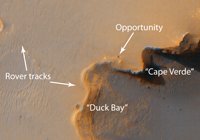
Seeing is
believing: the Rover Opportunity form space... NASA.
|
MRO
Captures a Rover on photo
JPL
news release, 6 October 2006. Adapted from full article.
NASA's rover Opportunity has started to explore layered rocks in
cliffs around the massive "Victoria crater" on the planet Mars.
While Opportunity was busy inspecting the crater's features, NASA's latest
satellite to arrive at Mars photographed the rover and its surroundings from
above. And the rover is but the size of a golf car! The level of detail in
the photo from the high-resolution camera on the Mars Reconnaissance
Orbiter will help guide the rover's exploration of crater Victoria.
Within two months after landing on Mars in early 2004, Opportunity found
geological evidence for a long-ago environment that was wet. The rovers
have worked on Mars for more than 10 times their originally planned
three-month missions. |
________________________________________________________________________________________
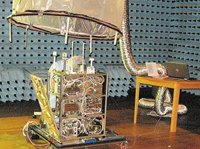
|
South Africa's second satellite scheduled for December launch
SA's
second satellite is named Sumbandila, a Venda name meaning 'lead the way'.
The name was suggested independently by three pupils across the country.
The 1.8-metre SumbandilaSat weighs 80 kilograms and plans call for its launch
from a submarine in Russia's Barents Sea in December 2006. The satellite has a low orbit and will be used for research
into fields such as geographical mapping, telecommunications and broadcasting,
climatic studies, disaster management and more. The launch is seen as an important milestone for
South Africa's utilization of space resources. The constructor,
SunSpace, also built SA's first low orbiting satellite in 1999. Photo at
left: SunSpace
Tecnical
details at http://en.wikipedia.org/wiki/Sumbandila |
2. Astronomy news from around the world |
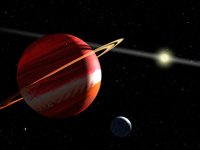
An artist's concept of a Jupiter-mass planet orbiting
Epsilon Eridani.
|
Together
with Earth-based telescopes, NASA's Hubble Space Telescope has provided
scientists definitive evidence for the existence of the nearest extrasolar
planet to our own solar system. Planets orbiting other stars are also
referred to as "exoplanets".
This Jupiter-sized world orbits the star Epsilon Eridani, which is a mere
10.5 light-years away. The exciting news is that the planet is so close that
it might be observable by Hubble and large ground-based telescopes in late
2007, when the planet makes its closest approach to Epsilon Eridani during
its 6.9-year orbit.
As at 2 October 2006, 208 exoplanets have been
discovered. More about exoplanets: http://en.wikipedia.org/wiki/Extrasolar_planet |
________________________________________________________________________________________
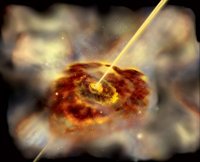
Artist rendering of a black hole. A black hole is
the remnant of an incredibly big star that came to the end of its life.
Photo: NASA
|
Supermassive Black Holes on Swift roll-call
Goddard
Space Flight Center News Release, 7 October 2006. Adapted from full
article.
NASA scientists using the Swift satellite have conducted the first complete
census of galaxies with active supermassive black holes, over a nine-month
period. The survey detected more than 200 supermassive black holes
called Active Galactic Nuclei, or AGN, and provides a definitive
census of black hole activity in the local universe (within 400 million light
years from our solar system).
AGN's have a mass of millions to billions of suns, which are confined within
a region about the size of our solar system. The term "active"
refers to the process of actively pulling in gas and even whole stars and generating
large amounts of energy in the process (e.g. like quasars and Seyfert
galaxies). Nearly every massive galaxy seems to have a supermassive black
hole, but only a few percent appear to be active. Our galaxy's central black
hole is dormant, and this and similar black holes are not included in the
Swift census.
All black holes were likely once active, and why some remain active and
others are dormant in the modern, local universe is a mystery. |
________________________________________________________________________________________
Other news:
Space Tourist returns home - 28 September 2006
A Russian
Soyuz capsule carrying outgoing space station commander Pavel Vinogradov,
NASA flight engineer Jeff Williams and space tourist Anousheh Ansari
undocked from the international lab complex and returned to Earth end of
September 2006: http://www.spaceflightnow.com/station/exp13/060928landing.html
Mars
Rovers, Mars Global Surveyor and Mars Odyssey Orbiter missions extended - 26
Sep 2006
The missions of
the twin Mars Exploration Rovers, Spirit and Opportunity, (which arrived at
Mars in January 2004), won approval for an additional year of
exploration. NASA is also adding two more years of operations for Mars
Global Surveyor, which has been orbiting Mars since 1997. The Mars Odyssey
orbiter also got a one-year extension, it's been at Mars since 2001.
http://www.spaceflightnow.com/news/n0609/26rovers/ |
3. Interesting Space Facts |
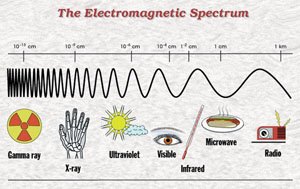
Credit: Herschel Space Observatory
http://herschel.jpl.nasa.gov/farIRandSubmm.shtml
|
Beyond visible light
- Stars and other bodies in space emit radiation in a range of different
wavelengths. Humans can see the visible part of the electromagnetic
spectrum. Special telescopes on the other hand, can even see in
frequencies such as radio waves.
- Radio
waves, microwaves, x-rays, gamma rays, and the spectrum of visible colors are
all actually the same thing - electromagnetic energy. The difference lies
with their wavelengths. Radio waves are long, measuring as much as hundreds
of meters between peaks. Gamma ray wavelengths are very short on the other
hand, sometimes as little as trillionths of a meter. From: http://herschel.jpl.nasa.gov/farIRandSubmm.shtml
- Optical, radio and some infrared rays can penetrate the Earth's atmosphere.
In order to "see" cosmic rays in the form of Gamma rays, X-rays and
UV rays (the shorter wavelengths), scientists launch sophisticated orbital
space telescopes. |
4. The Solar System: Venus |
3rd of 12-part series about
the Solar System.
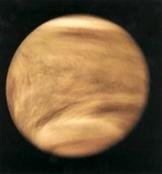
Venus from
space. The atmosphere is so thick that you cannot see the surface. (JPL/NASA)
|
Venus is the second planet from the
Sun. It is also known as the "evening and morning star", although
it is not a star at all! It is the brightest heavenly body after the Sun and
Moon that we can see from Earth - time and again Venus has been mistaken for
a 'UFO' because of its brightness and proximity to the horizon.
You will probably not want to go to Venus for a holiday. For a start, its
surface temperature can reach an incredible 470 °C! (hottest of the planets,
even hotter than Mercury). The atmospheric pressure alone is 90 times more
than Earth's. When standing on Venus, it will feel as if you are 900 meters
under the sea... The atmosphere consists of 97% carbon dioxide and the
upper part of sulphuric acid.
The surface is completely rocky and seismic-wise relatively quiet, but active
volcanoes and lava flow are present. Life on Mars will have a hard time - it
will not only be melted and fried, but also squashed and suffocated!
Nevertheless, Venus is still a very interesting planet. It has no moons, and
is almost as big as the Earth. A day on Venus is equal to 243 Earth days (compared to Earth's 24 hours)! ESA's Venus Express is the satellite currently
studying the planet from orbit.
|
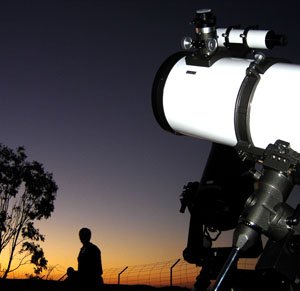
|
Planets
- October
2006
Mercury is visible in the evening sky just above the western horizon
for the entire month. Venus and Mars are too close to the sun
for proper observation. Earth is that quaint bluish little rock
hanging in space about 150 million km away from its star. Next time you visit
it, try some yummy potjiekos. Jupiter shines bright in the evening sky
towards the west, for the whole month. Saturn is visible in the
morning sky.
Uranus is in Aquarius, magnitude 5.8. It will look like a star through
a binocular - the disc will start to resolve through an 8 inch telescope.
Neptune is in Capricornus, magnitude 7.8. A telescope is required,
but don't expect to see the disc with a small one!
Pluto is in Ophiuchus, just over magnitude 14. Use a large telescope with
camera equipment and observe over a period of time!
Constellations - October 2006
Find Pegasus
(the Flying Horse) in the north-east later in the evening. It's not difficult
to learn. Below Pegasus very close to the horizon is the constellation of
Andromeda, famous for housing the farthest object visible with the naked eye:
Andromeda Galaxy (M31)...
Other night sky
events
- Full Moon on 7 October 2006. New Moon on 22 October 2006.
- The Orionid Meteor shower peaks on the morning of 21 October 2006. Under a
dark sky, expect up to 20-30 meteors an hour. |
__________________________________________________________________________________________
Deep Sky Delights - October 2006
Star
Birds of Paradise and objects in Phoenix - a wonderful account of the birds
in the sky! http://assa.saao.ac.za/html/deepsky_delights_2006_october.html
Watching the International Space Station from your back yard
Did
you know that you can look at the ISS, the Hubble Space Telescope and Iridium
Flares from your home in the city? Select your neighbourhood from www.heavens-above.com and off you go!
The Power of Binoculars
Never
underestimate the power of binoculars when it comes to astronomy. You will be
amazed at how many stars and interesting objects you can see. A 10x50
binocular is a good choice while some amateur astronomers prefer a 12x50.
Stellarium
You will have to excuse me, but I'm going to make you crazy with Stellarium!
This program is so incredible that I wish I could eat it. www.stellarium.org. |
6. Amateur Astronomers' Corner |
Variable
Star Observations
An interesting
pass time with a number of amateur astronomers is to observe variable
stars. It is also an opportunity for an amateur to directly contribute to
professional astronomical research. Although there haven't been (and still
aren't) many active variable star observers, some of the greatest names in
South African amateur astronomy was involved in variable star observations.
You can also become involved and you don't even need expensive equipment (you
can even observe variables from your back yard).
Variable stars are stars that change in brightness and some changes can
be detected over a period of time even with the naked eye. Over 30,000
variable stars are known and catalogued (source),
and many thousands more are suspected to be variable. There are a number of
reasons why variable stars change their brightness. Have you ever looked at
the star Mira in Cetus? Come back in a few months' time and you won't believe
your eyes!
Why observe them? According to the AAVSO website: "Variable stars
need to be systematically observed over decades in order to: determine the
long-time behavior of a star, provide professional astronomers with data
needed to analyze variable star behavior, to schedule observations of certain
stars, to correlate data from satellite and ground-based observations, and to
make computerized theoretical models of variable stars".
South Africans can contact the Director of ASSA's variable star section,
Brian Fraser, for more information: http://assa.saao.ac.za/html/36_variablestarsection.html
You can also find a wealth of information, including tips on how to start on
AAVSO's website: http://www.aavso.org/vstar/ |
7. Astronomy in Southern Africa |
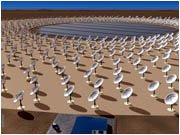
Part of
the core of the SKA - artist concept. Credit: SKA. |
South
Africa shortlisted to host the Square Kilometer Array (SKA)
SKA press release,
28 September 2006: http://www.ska.ac.za/press/28092006.html
South Africa and Australia have been selected from 4 countries to possibly
host the SKA project. News about the two runner-ups came on 28 September
2006. The SKA will be the largest radio telescope the world has ever seen. It
will be a great scientific step forward for the country that gets the honour.
The price tag is about R10 billion. The SKA will consist of many small
antennas, with a dense inner core that becomes further apart as you move away
from the centre.
Hosting the SKA in South Africa will boost the development of high level skills
and cutting edge technology infrastructure and will also attract expertise
and collaborative projects to the continent. (SKA website).
|
_________________________________________________________________________________________
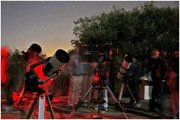
Telescopes on the observation platform at Boyden during the Symposium. Hannes
Pieterse.
|
7th
ASSA Symposium held in Bloemfontein South Africa
ASSA held their
7th national astronomy symposium at Boyden Observatory, Bloemfontein. The
event was attended mostly by amateur astronomers from all over South Africa
and also professional astronomers. The international guest was Dr. Patrick
Seitzer of the University of Michigan in the USA. Official website: http://www.assabfn.co.za/symposium2006/
Information about the Symposium has been posted on the national ASSA website,
as conveyed in the October issue of ASSA's National web news:
- Feedback
on the Symposium by Magda Streicher
- ASSA awards
and certificates handed out at the Symposium
- 4 asteroids discovered at Boyden given names during Symposium, of which one was named
after Mark Shuttleworth
- Project 27:
the dream to establish the largest educational telescope in SA at Boyden
- Actual program of events and list of speakers |
Regulars:
__________________________________________________________________________________________
ASSA
national web news update
Subscribe
to the free ASSA web
update service. You receive a monthly email with links to news and
events in Southern African astronomy.
__________________________________________________________________________________________
October
Skies: Highlights
A
detailed look at what's up in the sky in October 2006: psychohistorian.org.
8. Astronomy events in Bloemfontein |
Boyden
Open Evening/Ope-aand: Saturday 14 October 2006 / Saterdag 14 Oktober 2006
Plek: Boyden Sterrewag, Bloemfontein (bo Maselspoort).
Tyd: 18h30 vir 19h00
Koste: R30 per voertuig
Bespreking noodsaaklik: 051-401 2322
Die tema vir die aand is “Waarnemings van die Son: naaste ster aan die
Aarde”. Die spreker is Mnr. Jacques van Delft, direkteur van die
nasionale sterrekunde vereniging (ASSA) se Son afdeling. Besoekers
kan
deur teleskope kom kyk en sal konstellasie toeligtig ontvang. Indien dit
bewolk is gaan die aand steeds voort.
Venue:
Boyden Observatory, Bloemfontein (above Mazelspoort)
Time: 18h30 for 19h00
Cost: R30 per vehicle
Reservations: 051-401 2322
The theme for the evening is “Observations of the Sun: closest star to the
Earth”. The speaker is Mr. Jacques van Delft, director of the
national astronomy society’s Solar Section (ASSA). Visitors can also look
through telescopes and will receive a constellation show.
In the event of clouds the evening will go ahead.
Space Scientists to give talks at UFS: Sunday 15 October 2006
Venue: CR Swart Auditorium, UFS campus, Bloemfontein
Time: 19h30
Cost: Free
As part of Astronomy Month 2006 two space scientists are presenting talks in
Bloemfontein. Dr. Sima Adhya from the UK presents a talk entitled "Between a Rock and a Hard Place": how we know the Universe is
expanding, the formation of solar systems, including planets, moons and
asteroids. She has worked for NASA and is currently involved in an ESA
project to deflect an asteroid.
Dr. Lerothodi Leeuw's talk is entitled "Observational Study of Cosmic
Dust in our Galaxy and other nearby Galaxies". He will speak on and
show images about his astrophysical research on cosmic dust in the sky. He
will further discuss some of the latest findings about the field and how SALT
and SKA can be used for such research. |
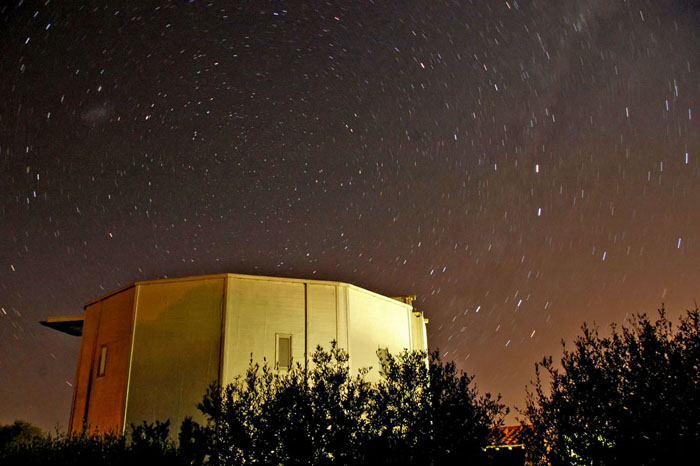
Dome of the 60 inch
UFS-Boyden telescope at Boyden Observatory, Bloemfontein, photo taken
by Hannes Pieterse on 28 September 2006 during the ASSA Symposium. The
telescope is also the 3rd largest optical telescope in South Africa and is
used in professional research projects (the search for exoplanets being the
main focus). The South celestial pole is visible directly above the dome.
|
_____________________________________________________________________________________________________________________
SpaceTides is a free internet e-zine for persons interested in expanding
their general knowledge of astronomy and spaceflight.
The e-zine originates from the City of Bloemfontein in South Africa and is
compiled us a service to the public by ASSA Bloemfontein Centre
as part of their educational outreach activities. Website: www.assabfn.co.za.
SpaceTides contains links to various other third party sites on the
internet, not always connected to SpaceTides. The persons and entities
responsible
for compiling SpaceTides will not be held responsible for the content or
information on these third party sites or any damage of any kind incurred
from
downloading, opening, or viewing anything from/through these sites.
Subscribe to SpaceTides by sending an e-mail to spacetides@assabfn.co.za with the word
"Subscribe" in the subject line.
If you
would like to Unsubscribe from SpaceTides, send an e-mail to spacetides@assabfn.co.za with the word
"Unsubscribe" in the subject line.
_____________________________________________________________________________________________________________________________
|



